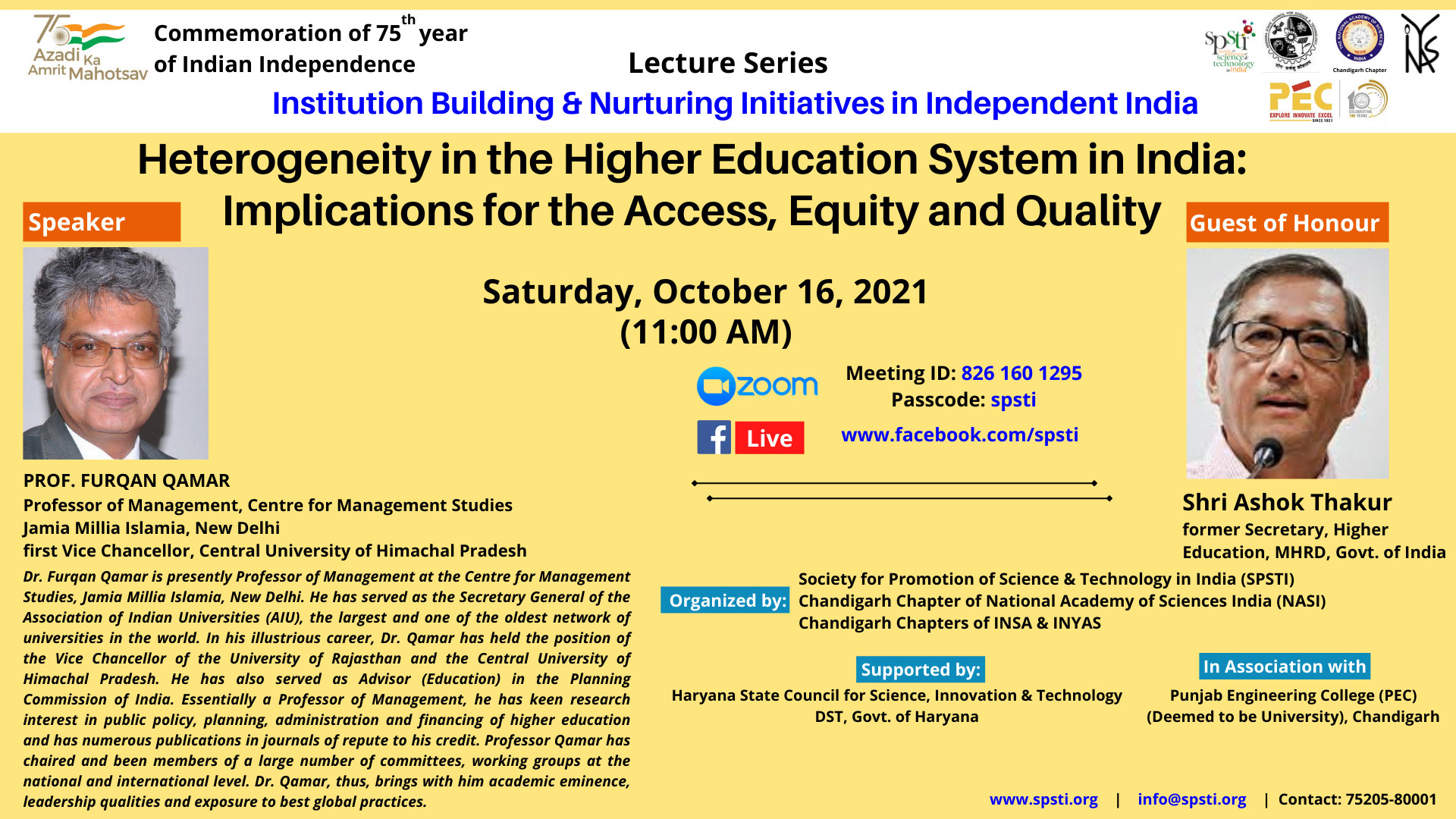To commemorate 75th year of Indian independence, SPSTI in association with Chandigarh Chapters of NASI & INYAS & PEC (Deemed to be University), Chandigarh, with support from Haryana State Council for Science, Innovation & Technology (HSCSIT), Govt. of Haryana has initiated a new series of lectures “Institution Building & Nurturing Initiatives in Independent India” on institutions strengthened, nurtured, planned and created since Indian independence in 1947.
The Society for Promotion of Science of Science & Technology in India (SPSTI) along with Chandigarh Chapters of the science academies, National Academy of Sciences India (NASI), Indian National Science Academy (INSA) and Indian National Young Academy of Science (INYAS), in association with Punjab Engineering College (PEC) (Deemed to be University), Chandigarh with support from Haryana State Council for Science, Innovation & Technology, DST, Govt. of Haryana, organized the second lecture in the series ‘Institution Building & Nurturing Initiative in Independent India’. The lecture ‘Heterogeneity in Higher Education System in India: Implications for Access, Equity and Quality’ was delivered by Dr. Furqan Qamar, the first Vice Chancellor of Central University of Himachal Pradesh, from 2010 to 2014. He is currently a Professor of Management at Jamia Millia Islamia, New Delhi. Organized on October 16, 2021 at 11.00 am through online mode, the session was attended by a large number of participants across India on Zoom and Facebook. The session was attended by many eminent educationists. It was steered by Prof. Keya Dharamvir, General Secretary, SPSTI, Shri Dharam Vir, IAS (Retd.), President SPSTI and Prof. Arun Kumar Grover, Former Vice Chancellor of Panjab University and Vice President of SPSTI who gave a brief overview of the series. Prof. B. S. Ghuman, former Vice Chancellor, Punjabi University, Patiala, introduced the Guest of Honour, Shri Ashok Thakur, former Secretary, Higher Education, MHRD, Govt. of India. Shri Thakur said that we need to take care of educational institutions at various levels – school education which is the building block for higher education, and whose quality needs to be improved, private universities where quality needs to be continuously checked and mainstreaming of skill education in university education systems. The speaker was introduced by Prof. Ronki Ram, a distinguished academician from the Panjab University, Chandigarh. Prof. Qamar in his talk focused on heterogeneity on the basis of three parameters – expansion, equity and excellence. He calls it the triple helix of education! India has the highest number of institutions but lacks in ranking; hence quality and access. Since Independence, the gross enrolment has improved considerably from 0.7% in 1950-51 to 27.1% in 2019-20. The speaker categorized the Higher Education Institutes into university level institutions, colleges and stand-alone institutions, further classified into government, government aided and private institutions. He further elaborated that the institutions differ mainly in terms of funding and student-centricity. Private institutions are more student-centric than the public institutions, but the reservation in the affirmative actions are applicable only to public institutions, both in jobs and in admissions. In an indirect way, some kind of affirmative action prevails in private institutions too, because of the fees reimbursement policies. He shared that if we compare the memorandum of association and the governance structure of the earliest Indian universities, Bombay, Calcutta and Madras with those of the newer private Institutions, they are found to be markedly different and have implications on affordability, access, equity and quality. The Central Sector university level institutions account for only 0.34% of the student population; the bulk of higher education being provided by colleges, which account for over 76%. The recent trends (over the past nine years) show that the number of the central sector institutions have grown by about 7%. The state sector has grown at the rate of 4%. India has more than 1,000 universities, including 54 central universities, 416 state universities, 125 deemed universities, 361 private universities and 159 Institutes of National Importance, including AIIMS, IIMs, IIITs, IISERs, IITs and NITs among others. Nearly, 4 crores students are studying in these institutions. With such a large number of students, it is important to improve quality. The NEP 2020 along with the Science, Technology & Innovation Policy 2021 is expected to bring a paradigm shift towards quality and relenave. With the passage of time, the number of students in higher education is expected to increase and the institutions and both Central and State Governments must gear up to meet the growing demand of higher education while focusing on quality The session was much appreciated by the audience consisting of eminent educationists who gave their own valuable inputs, bringing into focus the role of RUSA, NET, newer experiments with recruitment systems and Semester vs. Annual systems of instructions. The information about future lectures in the series will be available on the SPSTI webpage, www.spsti.org and lectures can be accessed on the SPSTI Facebook page.

